I swore I wouldn’t put in a butcher block countertop in a kitchen again. After our previous kitchen renovation where we had butcher block from IKEA, I was like nope. I can’t do this again. Because I know the reality of having a butcher block countertop on a daily basis.
Then some time passed. And I realized that a great deal of why I didn’t want a butcher block counter top again had to do with several key issues with the previous butcher block countertop we had, not butcher block itself. Seeing as we did put in butcher block into this kitchen which I can’t stop raving about, I obviously had a change of heart.
In which case, as part of the kitchen renovation series, I thought it would be a good (and helpful idea) to take the time to write a post about the pros and cons and reality of having a butcher block counter top, for everyone out there debating on whether or not to put one in.
The Pros and Cons of having Butcher Block Countertop
- First the basics. Remodelista has a great post about what exactly butcher block is (how it’s made), the types of butcher block (there are different styles) and the types of wood used to make them. It’s a good primer for butcher block 101.
- I wrote a very long post about staining our butcher block countertop where I break down different stains, oils and link up to a lot of great bloggers posts using different stains. If you’ve decided to get butcher block and you’re confused about what to do for stains and how to protect it, read this post.
- I wanted to share which butcher block countertop we went with this time, so you know which ones I am talking about to compare my experiences with in the previous house vs this one. And the ones we went for for this kitchen were from Lumber Liquidators.
Yes the flooring store, they sell butcher block countertops. Quite a few of them actually.
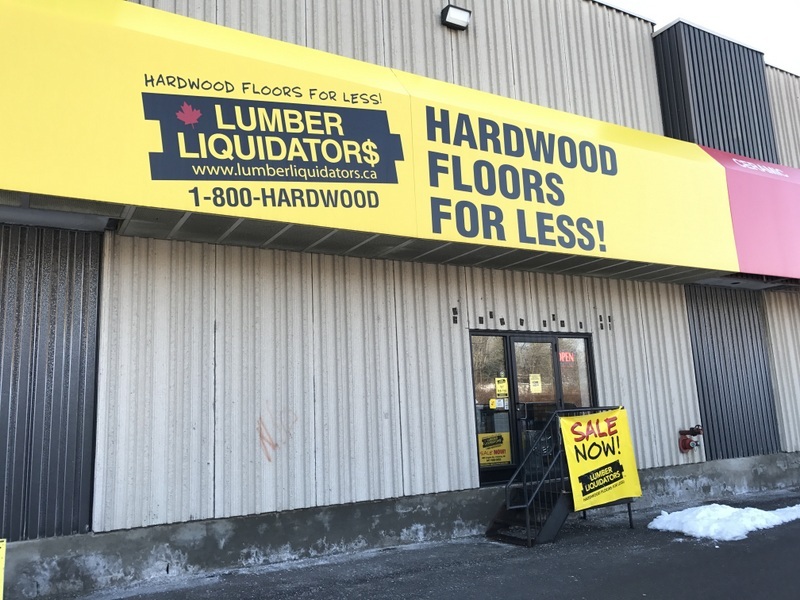
They have the following butcher block counter top choices:
- Maple
- American Cherry
- American Walnut
- Acacia
- Oak
- Hevea
- Teak
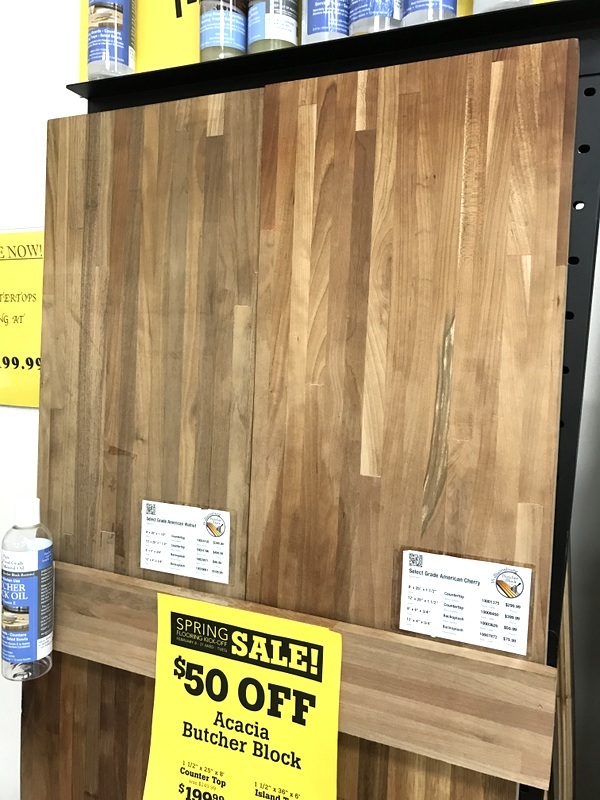
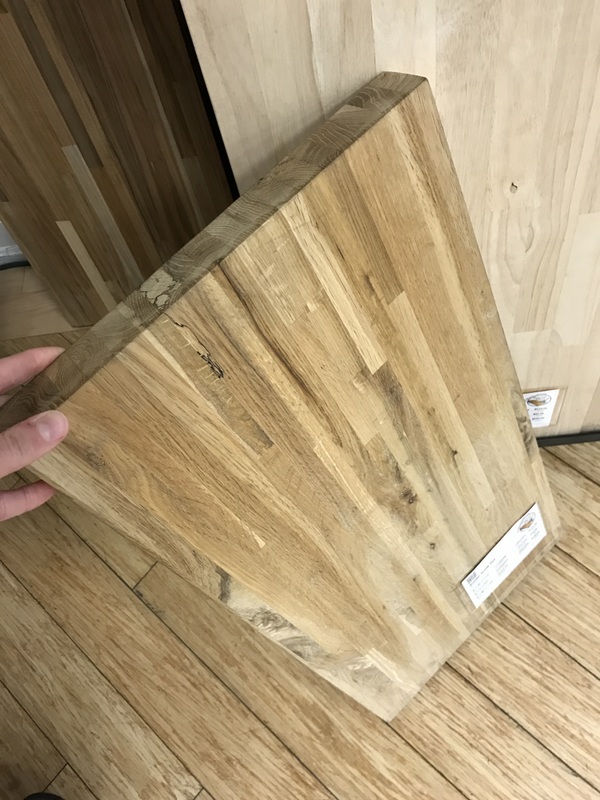
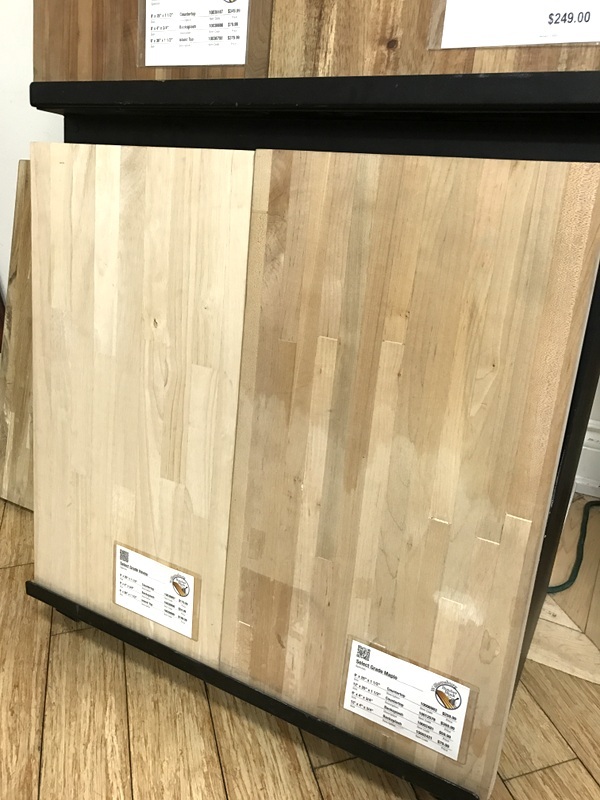
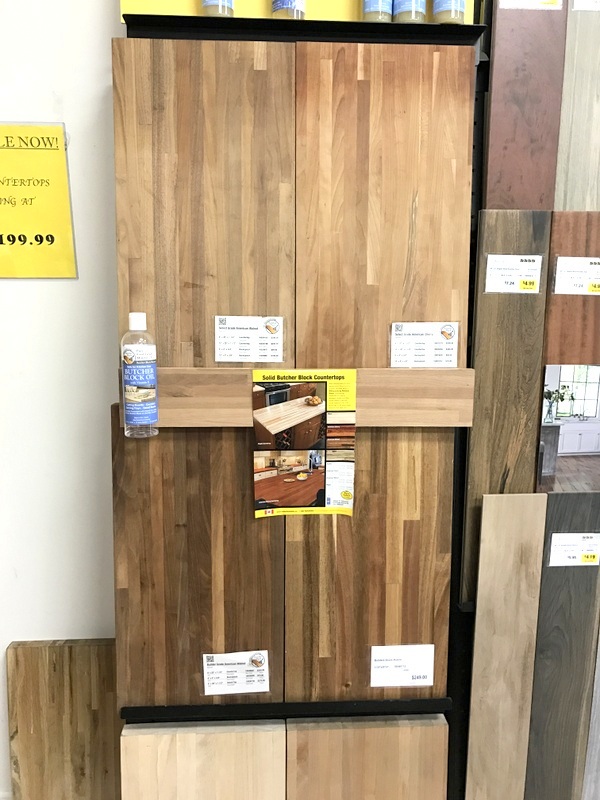
Some are made for islands, others are made for longer counter tops. They carry butcher block countertops up to 12 feet long. You know what that means?
No ugly kitchen counter seams.
It’s like the whole curtain length debacle. 84″ length standard curtains are commonly sold everywhere, when most people need far longer curtains than that. No one likes counter top seams, aka the unnecessary evil of longer kitchen counters.
WE CHOSE A WALNUT BUTCHER BLOCK COUNTERTOP
Now we had wanted walnut counter tops since even before the last kitchen renovation. I love walnut wood, I love how strong it is and I love the variations and warmth in the tones of the walnut. I mean look at this:
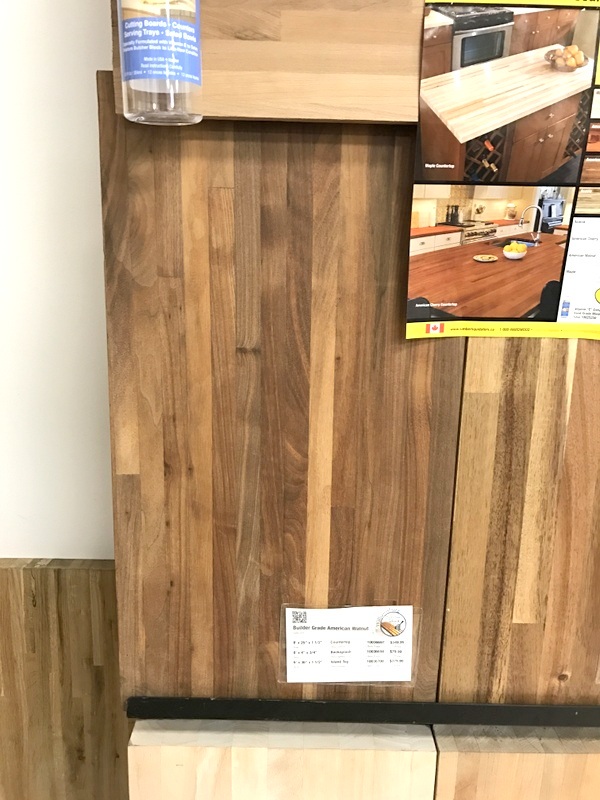
I didn’t realize that Lumber Liquidators sold butcher block prior to our previous renovation and had I known, things would have gone very differently.
But then I wouldn’t be able to tell you the differences between the butcher block from the place that sells furniture and Swedish meatballs, and Lumber Liquidators. So this is a little learning experience bonus. I did a lot of research on this counter before we decided on it.
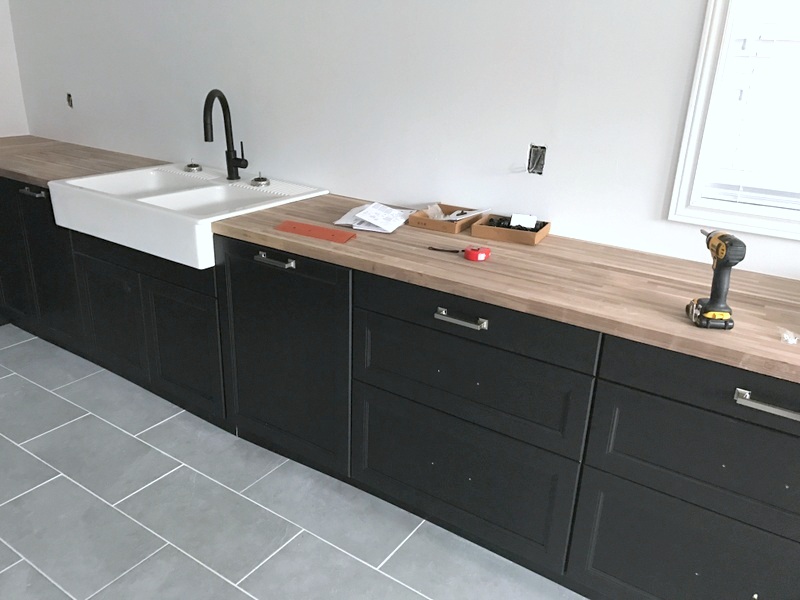
The most popular concerns and questions people have about Butcher Block.
THE FOOD SAFETY ISSUE
There’s this never ending rumour about wood counter tops being worse than other materials for bacteria and food. This NY Times article helps to dispel that myth. Turns out your plastic cutting board is probably leaching more stuff than you want it to.
The real food safety issue with wood counters comes from the sealers used on the counter tops to protect them from water damage. A lot of them obviously are not food safe. I discussed all of this in the post about staining butcher block.
The very obvious way of getting around this, is to use an oil to protect your counter tops vs a polyurethane sealant.
NOTE: At the time that I wrote this blog post, I was using plain oil mineral oil. I have since switched from mineral to Hemp Oil.
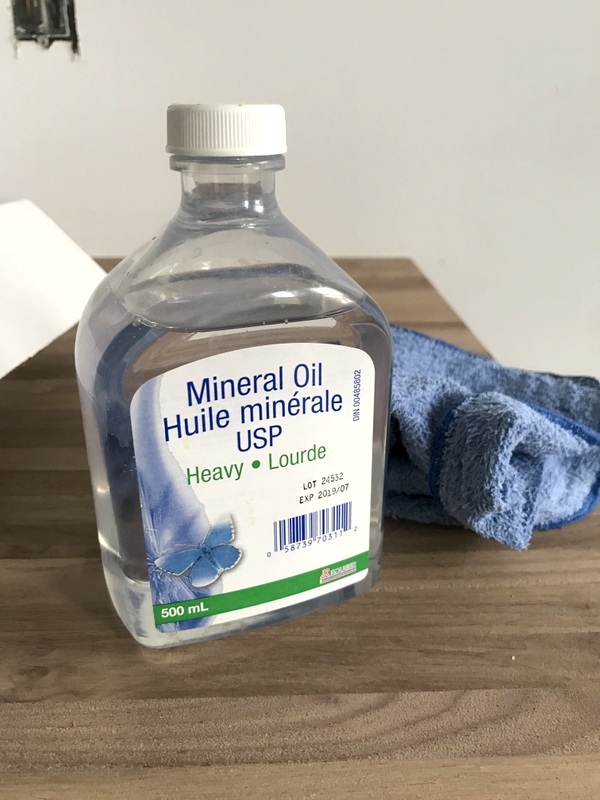
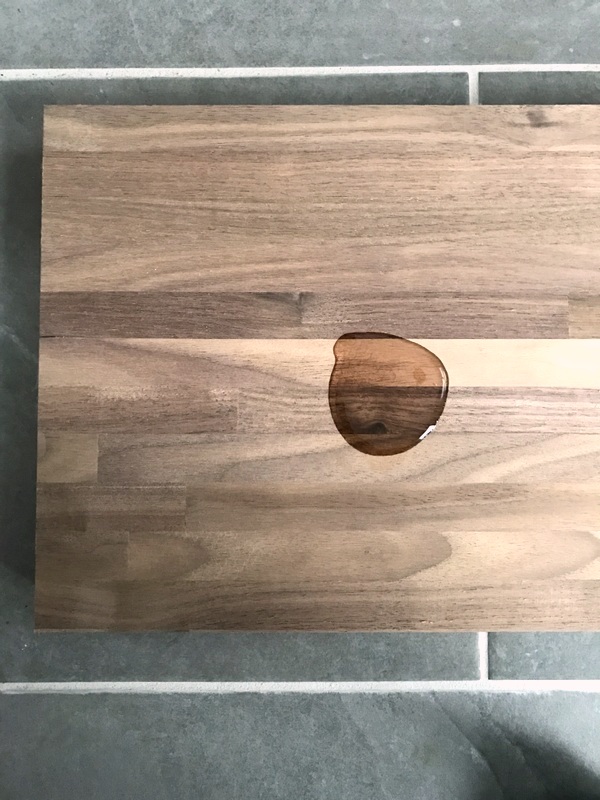
That being said, this is is ONE coat of mineral oil on the walnut butcher block. One coat. Look how pretty that is.
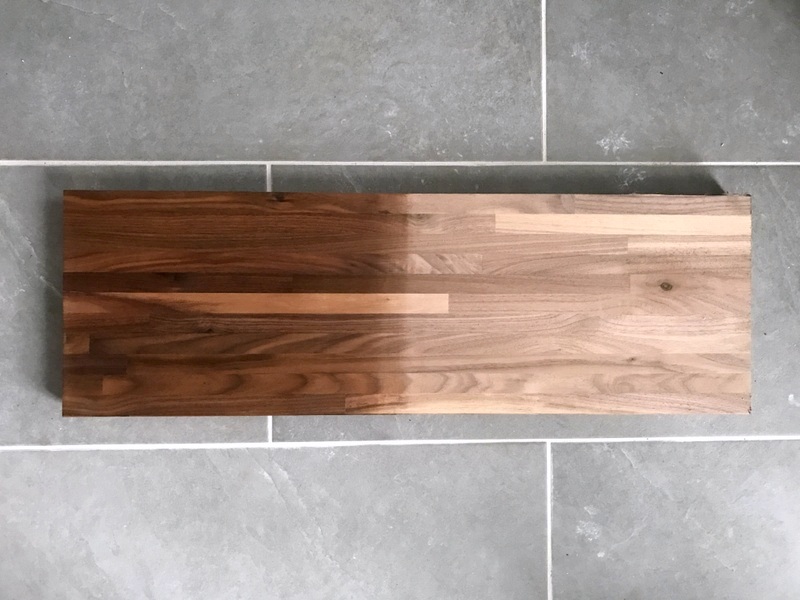
If you insist on staining your butcher block countertop, using a color stain, I recommend one of these products:
- a Dark Tung oil from The Real Milk Paint Company
- Tried and True Wood Stain
- Rubio Monocoat Zero VOC Finish
Or buy the counter tops in the color and species of wood that you want your counters to look like.
But again, read the butcher block staining post and you’ll find out why I didn’t go that route.
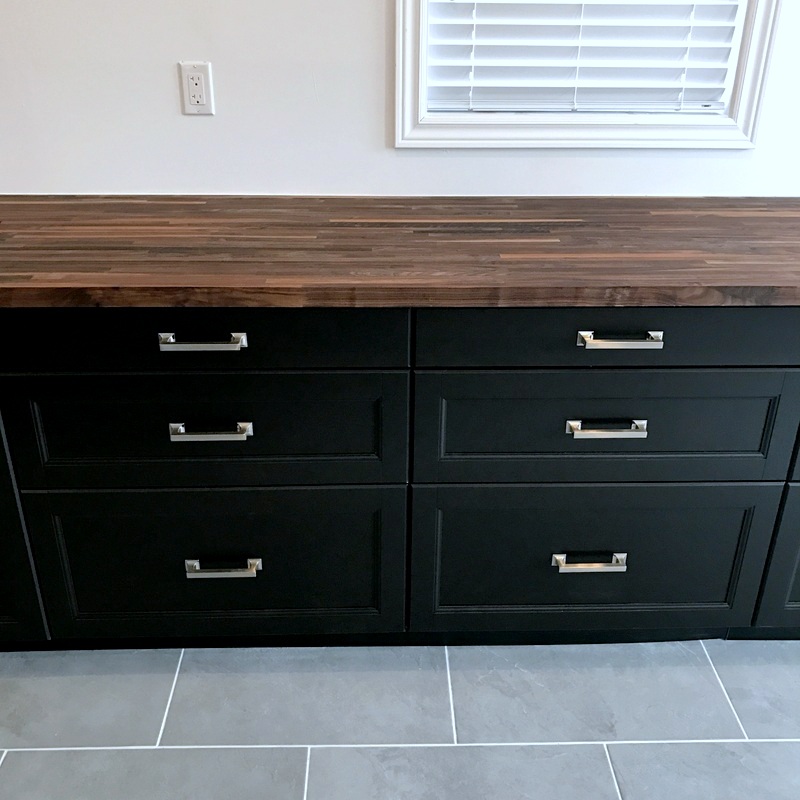
INSTALLING BUTCHER BLOCK COUNTERS
I was going to write a big post about installing the above counter tops, but it literally took our contractor no time to get them done and it was nothing fancy or complicated.
The counter tops were cut and screwed into the base cabinets from underneath. We did a Butt Joint (2 cuts side by side) vs a Miter Joint (45 degree angle) in the corners.
In our last kitchen we did a miter joint due to the proximity of the sink to the corner. It would have looked ridiculous to have a butt joint, leaving us with a slab of butcher block the size of a cutting board next to the sink.
But it’s a little more complex underneath and requires really precise cutting, so if you don’t know what you’re doing, it can wind up a complicated mess.
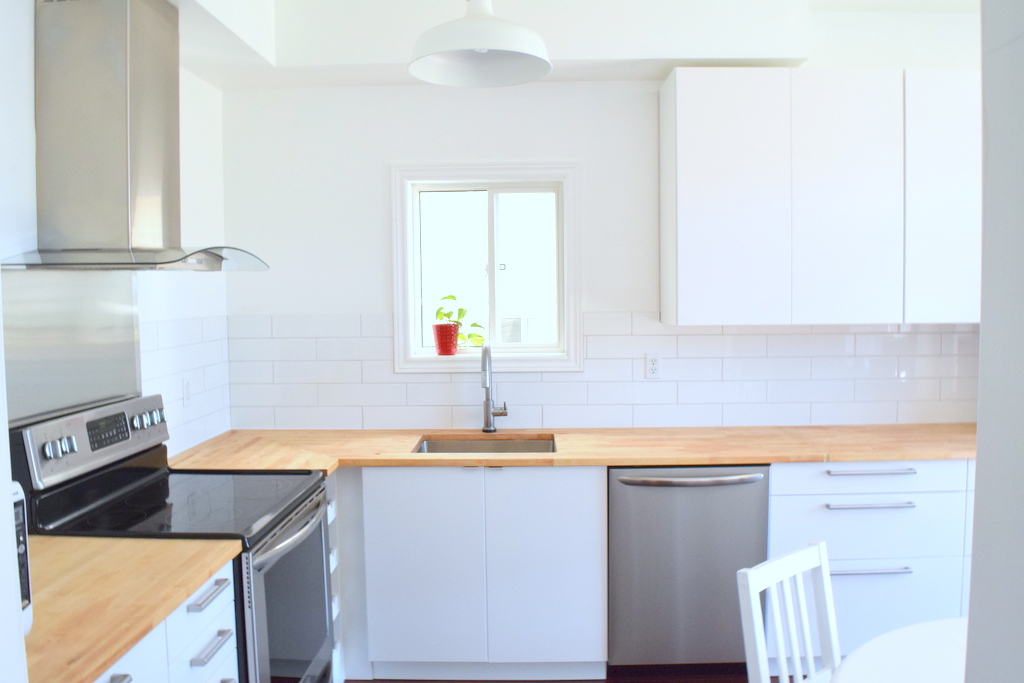
If you want a great tutorial on a miter cut for butcher block, go read the Fisherman’s Wife Furniture post on how they did their miter cut as they also used the walnut counter top from Lumber Liquidators.
And they used Waterlox. Which leads me to…
WHY WATER AND BUTCHER BLOCK ARE NOT FRIENDS
(and the reason I started to hate my old butcher block counters)
In our previous house we did an under mount sink in the butcher block counters. Looks very nice right? That’s where it ends.
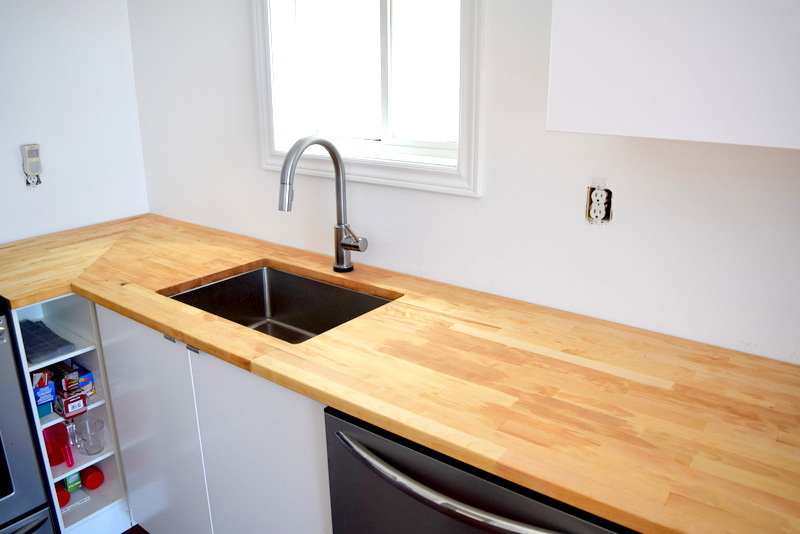
The problem with the under mount sink and that previous IKEA counter top is an interesting little story
Within 3 months of that photo above, the wood started splitting and buckling around the faucet, for the sheer reason that it was not coated with something better to protect it against water damage in an area where it will always be damp (duh).
Mineral oil was not enough.
I just could not stay on top of wiping the water around the sink area. I started to joke that having butcher block was like being in a high maintenance relationship, and an exercise in patience.
The area around the sink was always darker than the rest of the wood, but once it started to bubble up and split, I was just so disappointed.
After all of that, I still didn’t use the Waterlox due to reading about one too many bad experiences with the product, and because it leaves a sheen. I am not a fan of glossy wood counter tops. That’s just a personal aesthetic issue and I like my counter tops to feel and look like natural wood.
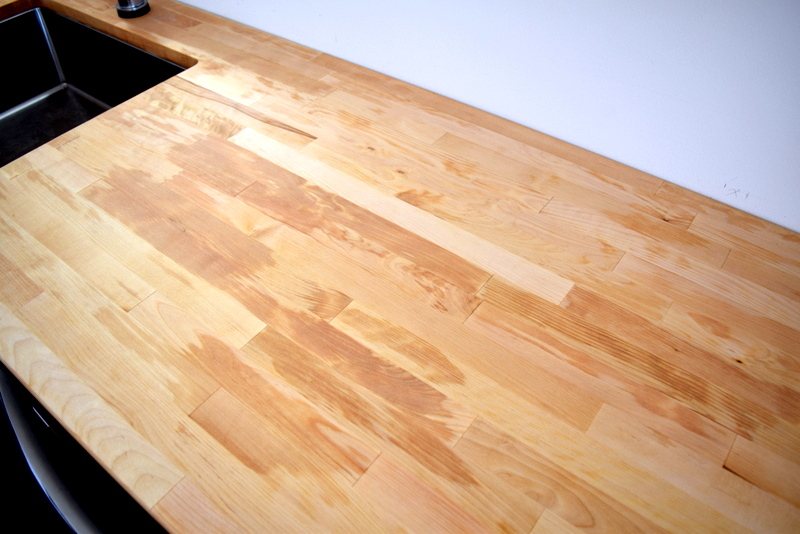
To solve that problem with this kitchen we went with a farmhouse sink that has no faucet installed directly into the wood. Note: our kitchen renovation is not done at the time that I am writing this, hence a lot of the process shots.
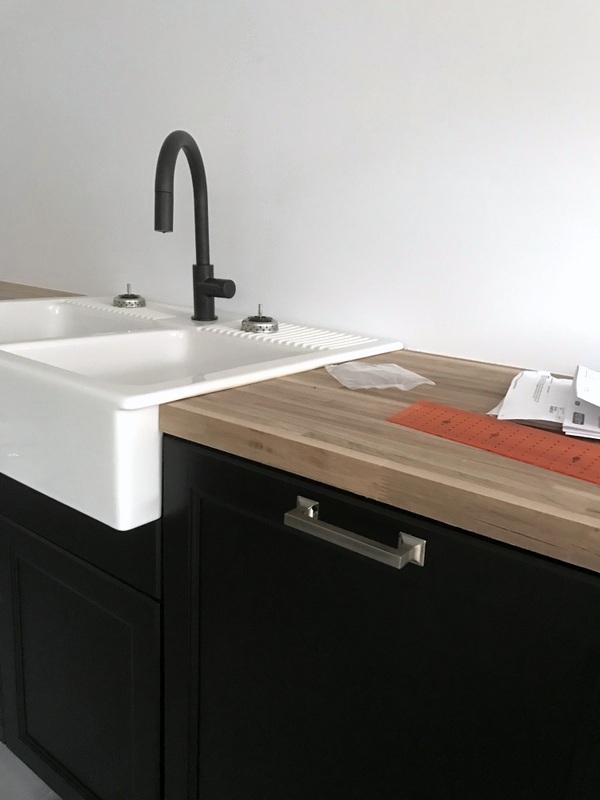
The other factor was the IKEA butcher block itself.
To compare IKEA’s butcher block to this walnut one we have now? There’s no comparison. In fact Sarah from The Ugly Duckling House uses an oil that is a mixture of beeswax and mineral oil on her walnut Lumber Liquidator countertops (told you, I researched these before we decided on them) and her under mount sink is fine.
That’s because this walnut butcher block is better. Period.
Our contractor who worked previously with IKEA and their kitchens for 10 years, as soon he installed ours, he was like this is way better stuff. It’s heavier, denser and far better quality. Our old IKEA counter? It also started splitting in places far away from the wet sink. Never mind that our first slab of butcher block from them was warped after we opened up the box. I became that disgruntled customer.
With this one? No issues. I have water dropped on this and rings from cups staying on it that dry without wiping and you can’t see a thing. In fact water pools differently on the walnut counter tops. It’s as if it doesn’t soak in. I credit that to the product and also the species of wood. Walnut is incredible.
If you are unsure of what species of wood to use for your counters, talk to a professional at Lumber Liquidators, and they will help you to decide on what type of wood will work best for your home.
NOTE: I have updated this post after having the counter tops for almost 4 years now and they are still in perfect condition and I treat them like crap most days.
SCRATCHES, DINGS, CAST IRON PANS AND KNIVES
In previous homes I have experienced granite, marble, laminate, and of course butcher block countertops. The worst one hands down for me was marble. I would never ever, ever, ever put down a marble countertop in the kitchen. It stained. It required special glosses and cleaners. It wore down far too easily around water and left a very dried out build up that looked like soap scum. Just no.
And then you think of granite, what could possibly be wrong with HGTV House Hunter’s mandatory preference of granite, circa early 2000’s? Ever have oil or wine stains absorb into granite? Good luck getting the stain out and it even shows in dark granite. And here’s a surprise to a lot of people, both of the above can chip.
Laminate counter tops? Durable, heat resistant, still crappy around faucets over time (our previous faucet rotted into the counter top). I have not tried Quartz or Soapstone or Concrete (so please chime in to dispel any myths or pros and cons on those). Bottom line is every countertop has had it’s own issues. Butcher block is no exception.
HERE ARE SEVERAL ISSUES WITH BUTCHER BLOCK
1. SCRATCHES
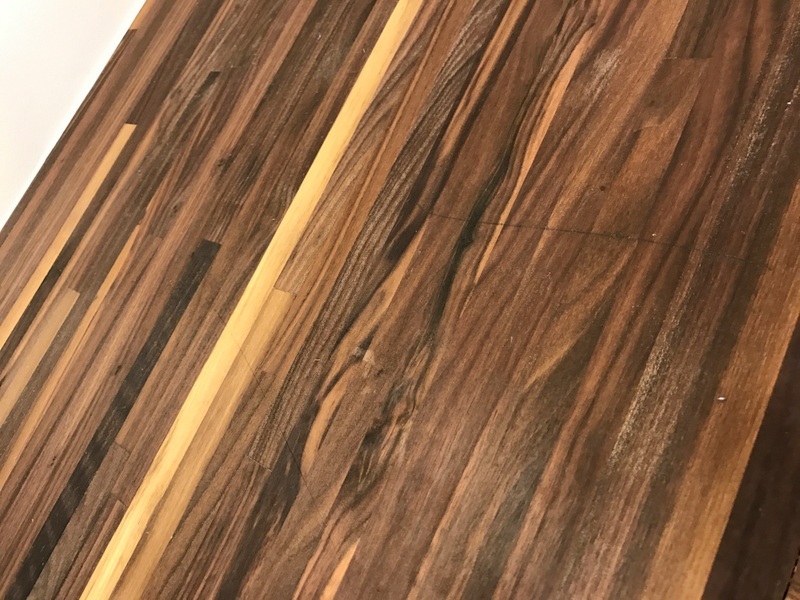
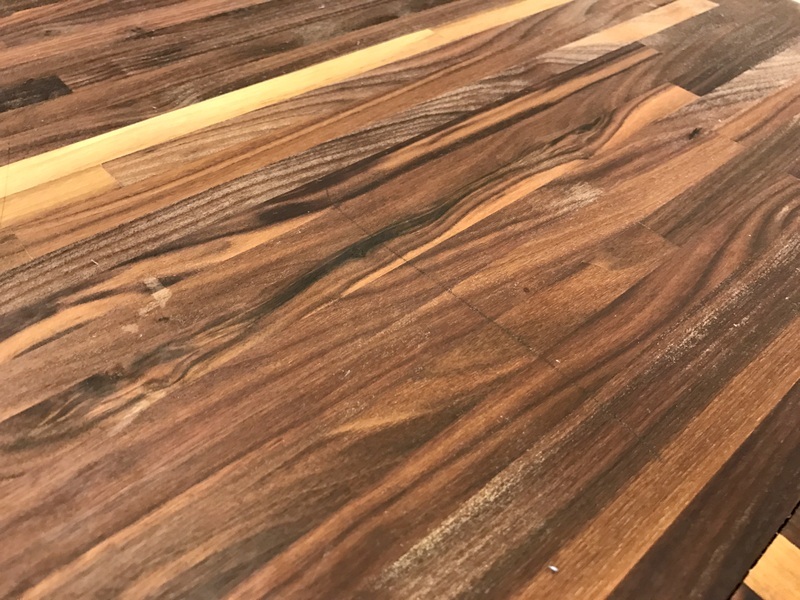
They will happen no matter what you do to try and avoid them. You either accept this or you don’t get butcher block.
The best part of this though is that unlike the travesty of trying to repair chipped marble, you can sand these down, re-oil and they will look as good as new.
2. ROUGH TEXTURE OF WOOD
Speaking of sanding, when wood gets dry, it can become a little rough. So if you’re used to wiping the counter with paper towels, imagine running a paper towel over this. You will have paper towel shreds over your counter and it won’t be fun to clean.

See the above photo? That’s unsanded.
The key thing here is to sand properly before oiling and to ensure proper maintenance by oiling your counters at least once a month. I am currently using Hemp Oil and am planning on getting this butcher block oil to test it out.
3. BURN MARKS AND CUTS FROM KNIVES
If you place a hot pot or cast iron pan on the counter top or chop directly on it, you’d better not care about burn marks and cuts on your surface. It’s one of those things where over time the dings and cuts and scratches all add character to a butcher block counter.
Cast iron pans WILL LEAVE A RING on your counters. A dark one.
The average warm pot, usually won’t but it “could”.
However if you’re one of those people who is adamant about making sure your counter looks immaculate, make cutting boards and table mats your best friend.
But now? Now I put hot pots directly on the wood (despite this photo below depicting otherwise) and the counter tops are fine. It’s several years later and I never use anything to put my pots and pans on top of. They go directly on the butcher block and all is well.
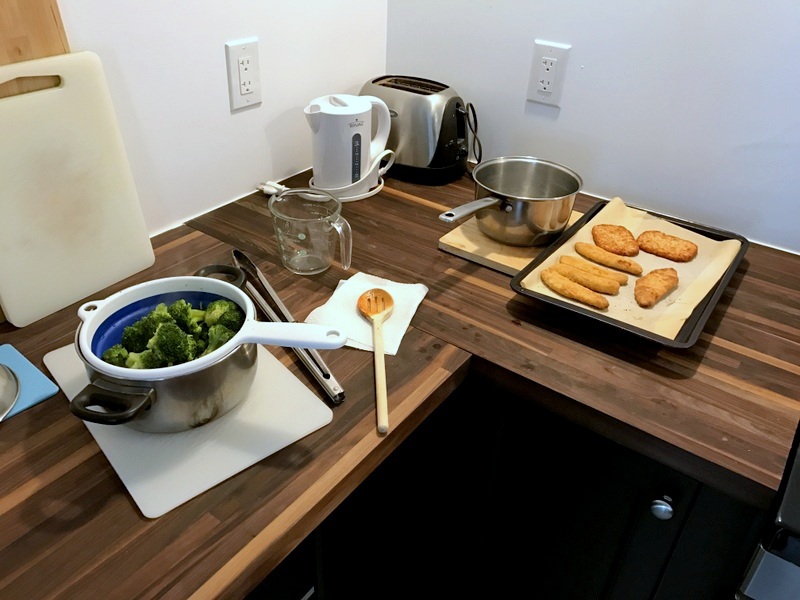
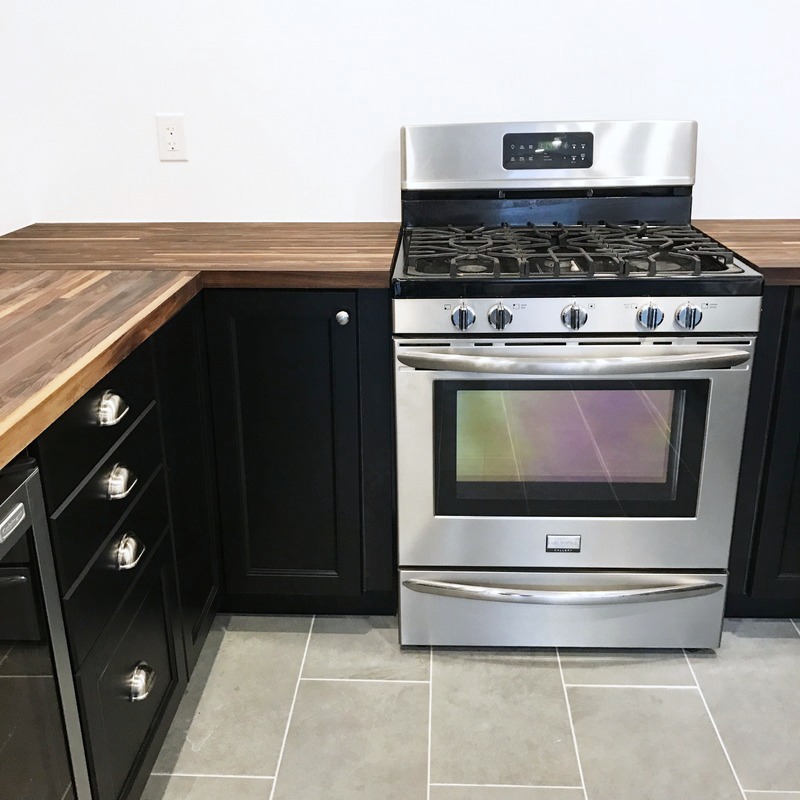
For the record, I miss how clean my Frigidaire Gallery Gas Range was in that photo. Sigh.
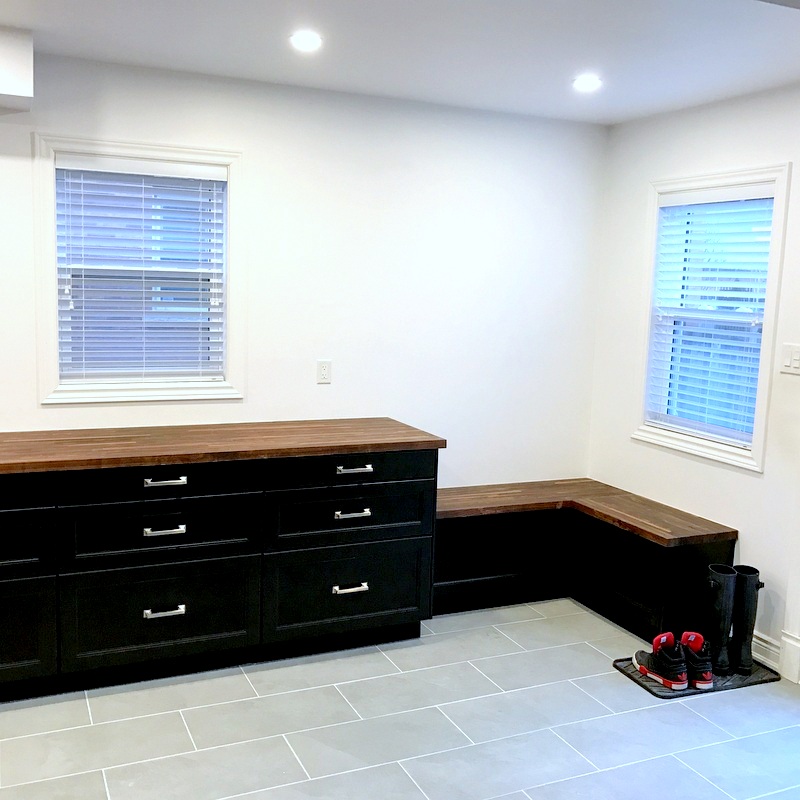
I also miss the kitchen looking this clean and new. That’s an IKEA Bench Hack we did using Kitchen Cabinets. Post to come!
WHY WE PUT THEM IN AGAIN
Here are my top reasons that I personally love Butcher Block:
- At the end of the day, I find that if you’re even considering butcher block, it’s because it’s up there in your list of Ride or Die counter tops. That’s just slang for the highest level of companionship with a friend/lover. In this case, an inanimate object. It just looks so damn good in any kitchen. Whether it’s the entire counter or just an island, it’s usually the first “Oh my God I love that!” reaction you get from your guests. No matter how many times I think I want something else, I always wind up pinning a kitchen with butcher block somewhere in it.
- It’s quiet and absorbs sound. I despise clanking or drumming noises. Putting away pots and pans causes me to flinch. There is no clanking of any kind on this counter with any dishes and if anything is dispels the noise level (well at least that’s what it seems to do in our kitchen around our kids – wishful thinking?)
- Cost effective. It is a very budget friendly choice.
- Warmth. It just makes the entire room feel cozy and warm.
- Easy to clean. I wipe down everything with a natural disinfectant spray (PS – please note I do not prep food directly on ours) or with just soap/dish detergent and water.
- Eco friendly. It has a low environmental impact due to how it’s made.
- The walnut color and species hides stains. If I tried to get you to tell me where any scratches are on this just by looking at it standing in the room, you wouldn’t be able to do so. With our previous counter top, every single mark could be seen from miles away. With this Walnut wood and tone, it masks anything. No extra wood stains needed. Just its natural color.
- Refinishes easily. Again, to make it look new with any scratches or dings, it’s as simple as sanding it down and re-oiling.
- The 12 foot length. Lumber Liquidators offers a 12 foot length. No unnecessary seams.
- If it’s good enough for Nate Berkus’ kitchen, it’s good enough for your kitchen.
If you have any questions or concerns, feel free to ask in the comments any time!
Disclaimer: I’d like to thank Lumber Liquidators for working with us on our kitchen renovation. They provided us the kitchen counter tops. As always, opinions are my own.
Please note that Lumber Liquidators has sadly closed their Canadian stores.
Their butcher block countertops are still available on their U.S. Website.

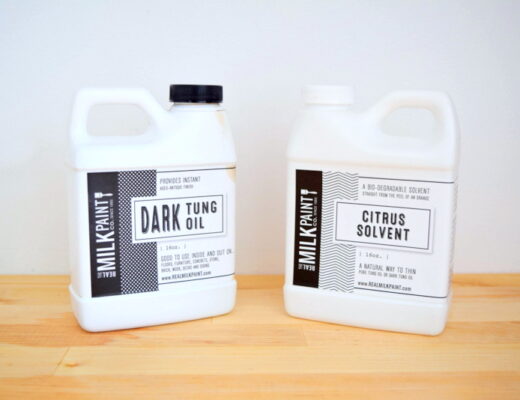
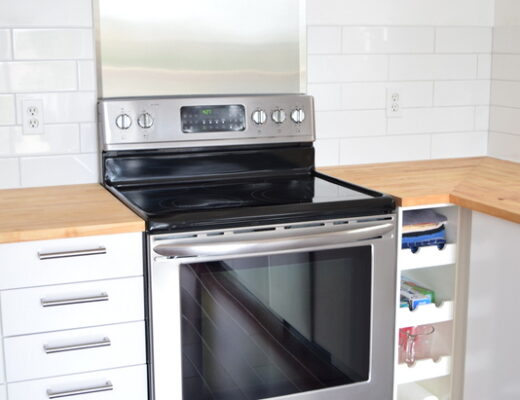
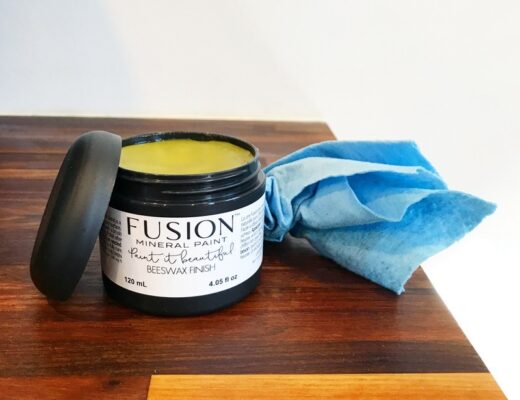
2 Comments
Inhome Flooring Denver
September 9, 2022 at 2:07 amThe price of this butcher block countertop is reasonable. It is a highly cost-effective option. I’m grateful that you shared this blog post.
Melinda Minks
February 19, 2023 at 6:36 amLooking to redo my kitchen, thinking about butcher block for my countertop. Does lumber liquidators do the cutting if I have the measurements? Thank you